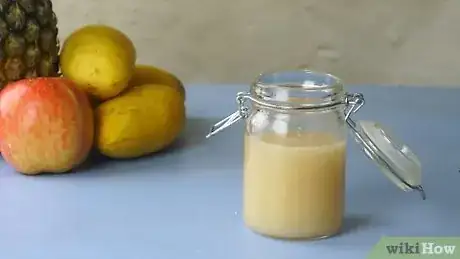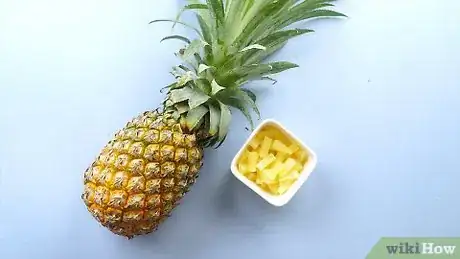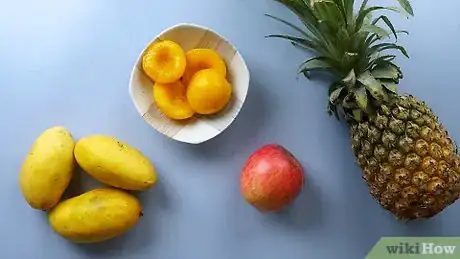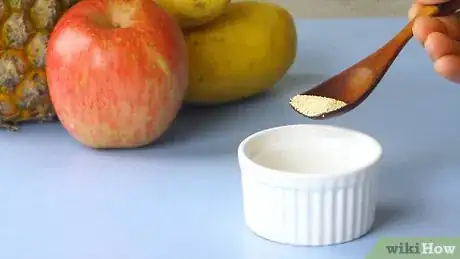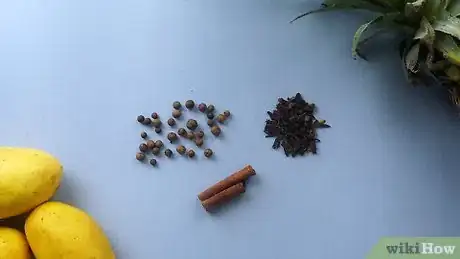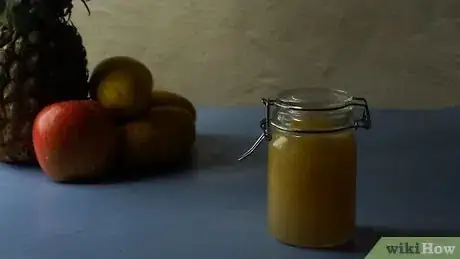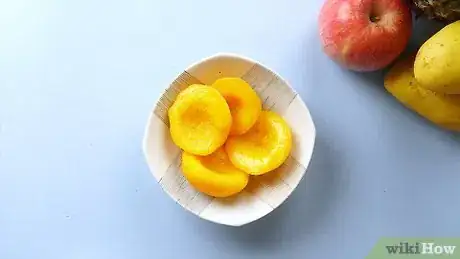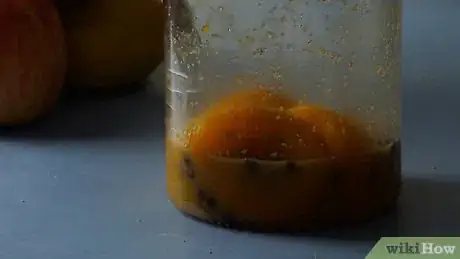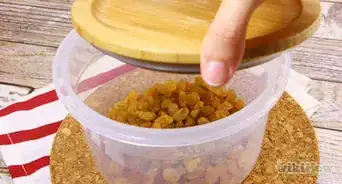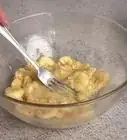wikiHow is a “wiki,” similar to Wikipedia, which means that many of our articles are co-written by multiple authors. To create this article, 18 people, some anonymous, worked to edit and improve it over time.
The wikiHow Culinary Team also followed the article's instructions and verified that they work.
This article has been viewed 518,077 times.
Learn more...
Fermented fruit can be an excellent gift to give family and friends. You can use the fruit to flavor alcoholic beverages or top your favorite desserts. Yeast breaks down the fruit sugars during the fermentation process, and you can use just about any type of fruit you want, although some will work better than others. Follow these steps to learn how to ferment fruit, either fresh or from a can.
Steps
Fermenting Fresh Fruit
-
1Make the fermentation syrup. When fermenting fresh fruits (as opposed to canned fruits) it's necessary to make the syrup and let it ferment for several days before adding the fruit.
- Start the syrup by mixing 1 cup of sugar with 2 cups of water and 1 packet of baking yeast in a jar with a loosely fitting lid. Pint or quart size mason jars work nicely.
- Stir the mixture repeatedly until the sugar dissolves into the water.
-
2Let the mixture ferment for about 3 to 4 days. Loosely replace the lid of the jar and let it sit at room temperature for 3 to 4 days.
- Look for bubbles to form at the top of the jar -- when you see these, you'll know that the yeast is alive and active and that the fermentation process has started.[1]
Advertisement -
3Choose a fresh fruit to ferment. Once the syrup mixture has been left to ferment for 3 to 4 days, you can add the fresh fruit. Refer to the section above for ideas on which fruits work best in fermentation.
- Use fruit that is fully ripe, with no bruises or blemishes. Choose organic where possible.
- Wash the fruits, remover any skin, large seeds or pits and chop or slice into even size pieces.
-
4Add the fruit. Open the jar of fermented syrup and add equal parts sugar and fresh fruit. Stir to dissolve the sugar.
- Congratulations -- you have successfully finished fermenting fruit. You can eat the fruit right away or you can loosely replace the lid and leave the flavors to develop for a few more days.
- This is also a good time to add any additional flavors, like cinnamon sticks or vanilla pods.
Understanding Fermentation
-
1Choose your fruit. Most fruits can be fermented, though some work better than others. Many people prefer to ferment canned or frozen fruits, as it reduces preparation time. If using fresh fruit, opt for ripe, organic produce with no bruises or blemishes.
- Fruits like peaches, plums and apricots are a popular choice for fermenting, as they are tasty and hold their color well. Wash the fruit, peel the skin and remove any pits.
- Exotic fruits like mangoes and pineapples ferment well and can be used to make chutney. Remove the skins and cut into even-sized cubes before using.
- Grapes can be fermented, but they must be pricked with a needle or cut in half to allow the cultured liquid inside.
- Peeled and sliced pears can be fermented, as can apples (though these tend to turn brown throughout the process, which some people find unappealing).
- Most berries can be fermented, except for blackberries which contain too many seeds. Strawberries ferment well in terms of flavor, but the syrup tend to bleach their color.
-
2Use a starter culture. A starter culture is simply a substance that contains beneficial bacteria which is used to kickstart the fermentation process.[2]
- For most recipes, it's not necessary to use a specific starter culture -- they are pretty much interchangeable.
- The most common starter cultures (especially for fermenting fruit as opposed to vegetables) are baking yeast, whey and special culture starter powders, such as Caldwell's starter.
- However, you can also use an opened probiotic capsule, the liquid from a previously opened jar of fermented fruit or a fermented beverage such as plain kombucha tea.
- To make a specific type of fermented fruit called Rumtoph (which is used in traditional German and Danish desserts) alcohol such as rum, wine, or brandy is used to encourage fermentation.
-
3Add some flavorings. Aside from the fruit, you can also add flavorings to the container to give the finished product more depth.
- Some popular additions include: cinnamon sticks, fresh mint leaves, cloves, vanilla beans, whole allspice, orange peel and almond extract. Which ones you choose are simply a matter of personal preference.
- You can add liquid flavorings or extracts to your fermenting fruit, but stay away from powdered spices -- these simply stick to the side of the container and ruin the appearance of the fruit. This is particularly important if you intend to give jars of the fermented fruit as a gift.
-
4Store the fermented fruit correctly. During the fermentation process, the container of fruit should be stored at room temperature, away from direct sunlight. Keep in mind that the unique conditions of your home will affect the success and speed of the fermentation process.
- You can keep the fermenting fruit in the refrigerator during periods of very hot weather, but keep in mind that this will more or less halt the fermentation process.
- Once the fruit has fermented fully, you should store it in the refrigerator, where it will keep for up to two months.[3] If you like, you can replace the fruit as you go -- this will keep the fermentation process going indefinitely.
- Keep in mind that fermented fruits should have a pleasantly sour taste, but they should not taste gone off or rotten. They should not be too mushy either -- fermented fruits should hold their original shape. So if you fruit looks mushy or smells bad, you should throw that batch out and start again. [4]
-
5Know what fermentation is and why it's good for you. Fermentation is a process used to preserve foods and increase the level of good bacteria they contain.[5] You shouldn't be intimidated by the fermentation process -- it is actually quite simple and straightforward!
- Basically, fermentation involves placing your chosen fruit in a jar or other container and adding a combination of water, sugar and starter culture (such as yeast or whey).
- The lid is then sealed and the fruit is left at room temperature for between 2 to 10 days. During this time, the starter culture will convert the sugar to alcohol, and carbon dioxide gas will be produced as a by-product, forming bubbles at the top of the jar.
- Once fermented, the fruit will contain an abundance of beneficial bacteria[6] and can be used as a condiment, dessert topping, or in recipes for things like chutneys, smoothies and salsas.
Fermenting Canned Fruit
-
1Choose a canned fruit. Open the can, and drain the liquid from the fruit.
-
2Place all of the ingredients in a jar. Add equal amounts of sugar and drained, canned fruit to a loosely lidded jar and then add a package of baking yeast and stir to combine.
- Stir until the sugar has dissolved (the moisture from the fruit will liquefy the sugar), add any flavorings, then loosely replace the lid of the jar.
- Leave approximately an inch of space at the top of the jar, as the volume will expand as the fruit ferments.
- The lid needs to be loose enough to allow the carbon dioxide gas to escape, but tight enough to prevent insects from getting inside.
-
3Allow the fruit mixture to sit in a cool, dark place. Fermentation occurs once bubbles appear on the fruit because the yeast is digesting the sugar and converting it into alcohol.
- Fruit tends to ferment quickly, in 24 to 48 hours. However, some people prefer to ferment the fruit for up to 2 to 3 weeks. This allows it to develop a much stronger flavor, as the syrup is converted into alcohol.
- The length of time you allow your fruit to ferment is a matter of personal preference. Try making several jars at once and leaving each of them to ferment for a different period of time -- this will help you to find the "sweet spot" between not fermented enough and too fermented.
Community Q&A
-
QuestionJust to clarify, are you saying a bread yeast packet will work?
 Community AnswerYup, any yeast will work, but certain yeasts can be bought specifically for making booze (like champagne yeast, etc.).
Community AnswerYup, any yeast will work, but certain yeasts can be bought specifically for making booze (like champagne yeast, etc.). -
QuestionCan I use honey instead of sugar?
 Community AnswerYes. The fermenting of honey produces mead, an old fashioned middle-ages style of drink.
Community AnswerYes. The fermenting of honey produces mead, an old fashioned middle-ages style of drink. -
QuestionInstructions read, "add equal amounts fruit and sugar" to the syrup. Does equal mean volume or weight?
 Community AnswerIt would be by weight. Although 8 ounces of sugar is about a cup, the fruit will be looser unless you really press it down. I always use weight for fruit and sugar, as I do when using honey for wine.
Community AnswerIt would be by weight. Although 8 ounces of sugar is about a cup, the fruit will be looser unless you really press it down. I always use weight for fruit and sugar, as I do when using honey for wine.
Warnings
- If the jar is kept too hot, the yeast will die. If the jar is kept too cold, the yeast will sleep. They need to be kept at room temperature to keep them active.⧼thumbs_response⧽
- Remember, fermentation will cause expansion, so you should not fill the jar more than 3/4 of the way full. If you do, it will expand to overflow the jar and make a mess.⧼thumbs_response⧽
- It is very important to close the jar loosely. If the carbon dioxide produced in the fermentation cannot escape, the pressure will rise and it will eventually explode.⧼thumbs_response⧽
Things You'll Need
- Jar(s) with loosely fitting lid(s)
- Fruit, canned, fresh, or frozen
- Sugar
- Yeast
- Water, if using fresh fruit
- Alcohol, if making a Rumtopf
- Flavorings, as desired
References
- ↑ https://dontwastethecrumbs.com/2015/02/beginners-guide-using-yeast/
- ↑ https://www.culturesforhealth.com/learn/general/five-culture-you-can-use-ferment-almost-anything/
- ↑ https://traditionalcookingschool.com/fermenting-and-culturing/how-to-store-fermented-foods/
- ↑ http://sharonglasgow.com/2013/01/8-fermented-food-recipes-for-your-health/
- ↑ https://www.thoughtco.com/what-is-fermentation-608199
- ↑ http://www.fao.org/docrep/x0560e/x0560e06.htm
About This Article
To ferment fruit, start by mixing sugar, water, and baking yeast in a jar. Then, loosely cover the jar and let it sit for 3-4 days at room temperature so it can ferment. Once the sugar water is done fermenting, peel and slice your fruit into small pieces. Then, add the fruit to the jar along with some more sugar. Finally, cover the jar with the lid and let the fruit sit for a few more days at room temperature so it ferments! To learn more about the differences between fermenting canned fruit and fresh fruit, keep reading the article!
